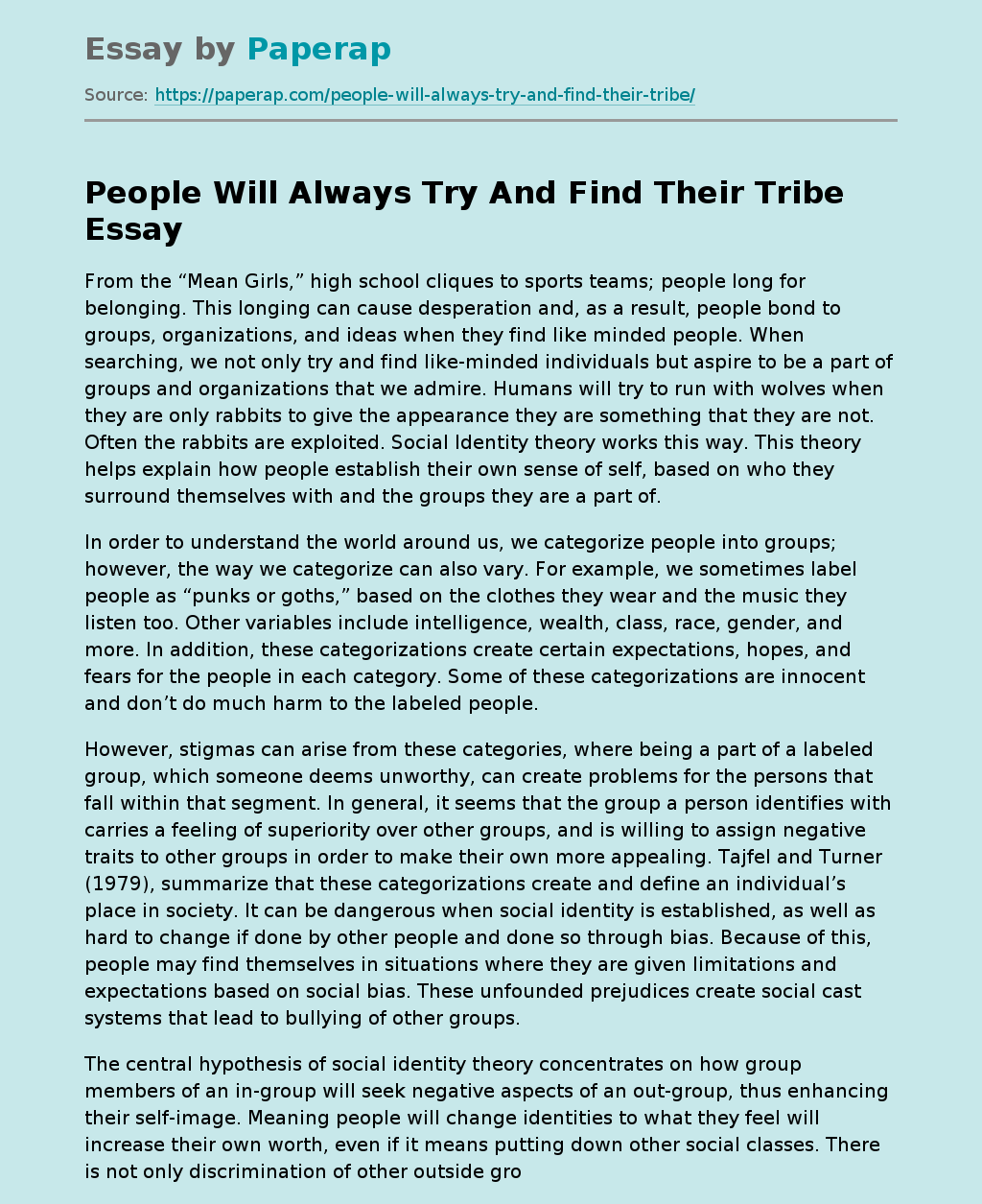People Will Always Try And Find Their Tribe
From the “Mean Girls,” high school cliques to sports teams; people long for belonging. This longing can cause desperation and, as a result, people bond to groups, organizations, and ideas when they find like minded people. When searching, we not only try and find like-minded individuals but aspire to be a part of groups and organizations that we admire. Humans will try to run with wolves when they are only rabbits to give the appearance they are something that they are not.
Often the rabbits are exploited. Social Identity theory works this way. This theory helps explain how people establish their own sense of self, based on who they surround themselves with and the groups they are a part of.
In order to understand the world around us, we categorize people into groups; however, the way we categorize can also vary. For example, we sometimes label people as “punks or goths,” based on the clothes they wear and the music they listen too.
Other variables include intelligence, wealth, class, race, gender, and more. In addition, these categorizations create certain expectations, hopes, and fears for the people in each category. Some of these categorizations are innocent and don’t do much harm to the labeled people.
However, stigmas can arise from these categories, where being a part of a labeled group, which someone deems unworthy, can create problems for the persons that fall within that segment. In general, it seems that the group a person identifies with carries a feeling of superiority over other groups, and is willing to assign negative traits to other groups in order to make their own more appealing.
Tajfel and Turner (1979), summarize that these categorizations create and define an individual’s place in society. It can be dangerous when social identity is established, as well as hard to change if done by other people and done so through bias. Because of this, people may find themselves in situations where they are given limitations and expectations based on social bias. These unfounded prejudices create social cast systems that lead to bullying of other groups.
The central hypothesis of social identity theory concentrates on how group members of an in-group will seek negative aspects of an out-group, thus enhancing their self-image. Meaning people will change identities to what they feel will increase their own worth, even if it means putting down other social classes. There is not only discrimination of other outside groups, but social inner group dynamics are conflicted. When people identify strongly with a group, they will confer leadership on members of the group who are weaker.
Thus, strengthening their own position within that group. This happens when members of the groups grant new members power and influence through social attraction and attributional processes. This is classic “Mean Girls”, where the new girl Cady gets adopted into the popular group and ends up becoming the leader of the pack. Sometimes, this means adopting the new person to make the existing group look more desirable. The social dynamics and inter-workings, or groups, are important to study because they exist everywhere. From classroom peer dynamics to professional relationships, we all seek to move up in social favor and not be categorized as part of the weaker group. Insecurity can drive people to do many things, in social identity this triggers a behavior called social comparison. Not only will people move from one group to the next, but they will also make fun of other groups to increase the security of the group that they are in. Social Comparison theory states that we measure our own self-worth based on how we perceive ourselves to measure up against others.
Occasionally this can foster positive outcomes, like self-improvement and positive self-image; however, comparing yourself too much can have negative effects. Today, we constantly appraise ourselves across a variety of domains, such as attractiveness, lifestyle, possessions, wealth, intelligence, and success. Social media has become a platform to promote and compare social identities. A notable example of our attempt to categorize is our use of hashtags. Hashtags are like keywords that can be used to organize content, movement, Ideas and messages on social networks. This then facilitates an organizational system that allows people to search for the grouping of content. Hashtags are marked by the pound sign and can be a word or a short phrase to indicate what it is referring to. These social displays are numerous due to the popularity and usage of social media including but not limited to: Facebook, Twitter, Instagram, Pinterest Snapchat YouTube, and more. For example, exhibitionists, or people who like to be seen; seemed to use social media to show affection, express their negative feelings, and achieve social recognition satisfying their social needs.
These self-evaluations can promote judgmental, biased, and superior attitudes. These attitudes can be towards individuals and entire groups, due to an individual’s social identity being threatened. Most people have the strength not to fall victim to stigmas and social cues. However, envy, combined with social standards needed for acceptance, can leave people feeling inadequate. This feeling of inadequacy can cause some to take drastic measures to feel socially accepted. One long-standing epidemic is beauty ideals. Society paints an image of beautifully thin women as the social standard and as needed to have the beauty identity. These standards create body dissatisfaction and often lead to eating disorder symptoms. A weakness to social identity theory is its similarity to identity theory, with no systematic communication between the two. There is more research to be done when discovering what and how a personal identity has been established and how it then reflects to establishing a social identity. These are two perspectives that exist parallel to each other but have not been explored together influencing each other in the same universe.
People Will Always Try And Find Their Tribe. (2021, Dec 05). Retrieved from https://paperap.com/people-will-always-try-and-find-their-tribe/

